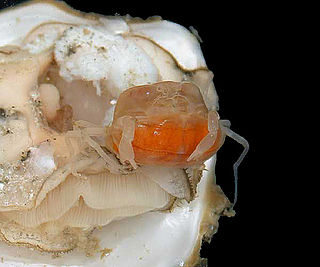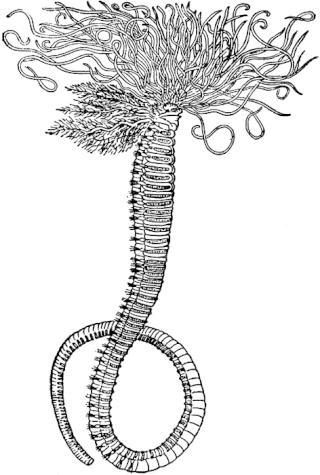
Nematomorpha are a phylum of parasitoid animals superficially similar to nematode worms in morphology, hence the name. Most species range in size from 50 to 100 millimetres, reaching 2 metres (79 in) in extreme cases, and 1 to 3 millimetres in diameter. Horsehair worms can be discovered in damp areas, such as watering troughs, swimming pools, streams, puddles, and cisterns. The adult worms are free-living, but the larvae are parasitic on arthropods, such as beetles, cockroaches, mantises, orthopterans, and crustaceans. About 351 freshwater species are known and a conservative estimate suggests that there may be about 2000 freshwater species worldwide. The name "Gordian" stems from the legendary Gordian knot. This relates to the fact that nematomorphs often coil themselves in tight balls that resemble knots.

Ovalipes ocellatus, known as the lady crab, is a species of crab from eastern North America. Other names for it include the leopard crab or Atlantic leopard crab due to the leopard-like rosette patterns on its shell, the calico crab, or ocellated crab. It has a shell 3 in (7.6 cm) long and only slightly wider, which is covered in clusters of purple spots. It occurs from Canada to Georgia, and lives mainly on molluscs, such as the Atlantic surf clam.

Stenorhynchus seticornis, the yellowline arrow crab or simply arrow crab, is a species of marine crab.

Enopla is one of the classes of the worm phylum Nemertea, characterized by the presence of a peculiar armature of spines or plates in the proboscis.

Petrolisthes elongatus, known as the New Zealand half crab, elongated porcelain crab, blue half crab, blue false crab or simply as the half crab or false crab, is a species of porcelain crab native to New Zealand.

The oyster crab is a small, whitish or translucent crab in the family Pinnotheridae.

Pinnixa faba, known as the pea crab, mantle pea crab or large pea crab, is a pea crab which lives harmlessly within a large edible clam. This species is a symbiont of Tresus capax and Tresus nuttallii in its mature stage.
Eupolymnia crassicornis is a tropical species of annelid, commonly known as a spaghetti worm. These worms are found mainly near the Florida Keys and Puerto Rico. They can be found on the sea bottom near rocks and sand. They live buried in the sand where they create a tube-like structure. They extend their thin white tentacles out of the top of the tube in which they dwell.

Chaetopterus or the parchment worm or parchment tube worm is a genus of marine polychaete worm that lives in a tube it constructs in sediments or attaches to a rocky or coral reef substrate. The common name arises from the parchment-like appearance of the tubes that house these worms. Parchment tube worms are filter feeders and spend their adult lives in their tubes, unless the tube is damaged or destroyed. They are planktonic in their juvenile forms, as is typical for polychaete annelids. Species include the recently discovered deep water Chaetopterus pugaporcinus and the well-studied Chaetopterus variopedatus.

Percnon gibbesi is a species of crab. It is one of at least two species commonly called Sally Lightfoot, and is also referred to as the nimble spray crab or urchin crab. It has been described as "the most invasive decapod species to enter the Mediterranean".

Crustaceans may pass through a number of larval and immature stages between hatching from their eggs and reaching their adult form. Each of the stages is separated by a moult, in which the hard exoskeleton is shed to allow the animal to grow. The larvae of crustaceans often bear little resemblance to the adult, and there are still cases where it is not known what larvae will grow into what adults. This is especially true of crustaceans which live as benthic adults, more-so than where the larvae are planktonic, and thereby easily caught.
Tumidotheres maculatus is a species of crab that lives commensally or parasitically in the mantle cavity of molluscs. It is found along much of the western Atlantic Ocean and was first described by Thomas Say in 1818.

Chaetopterus variopedatus is a species of parchment worm, a marine polychaete in the family Chaetopteridae. It is found worldwide. However, recent discoveries from molecular phylogeny analysis show that Chaetopterus variopedatus sensu Hartman (1959) is not a single species.

Amphitrite ornata or ornate worm, is a species of marine polychaete worm in the family Terebellidae.
Libinia ferreirae is a species of tropical spider crab in the family Epialtidae. It is found on the seabed in shallow waters off the Atlantic coast of South America.

Pyromaia tuberculata is a species of crab in the family Inachoididae.
Procaris hawaiana is a species of shrimp in the family Procarididae, from Maui, Hawaii. The species is very similar to Procaris ascensionis from Ascension Island. In P. ascensionis the integument is less firm, the rostrum is shorter, the cervical groove is more distinct, and the third abdominal somite reaches less far posteriorly over the fourth; also the scaphocerite has the final tooth still less distinct than in P. hawaiana, and the last segment of its antennal peduncle is less slender.
Alpheus tricolor is a crustacean belonging to the family of snapping shrimp. It was first isolated in Indonesia and Sri Lanka. It counts with a setose carapace, an acute rostrum, shallow adrostral furrows and a basicerite with a strong ventrolateral tooth. The lamella of its scaphocerite is not reduced, with an anterior margin that is concave. Its third maxilliped counts with an epipodial plate bearing thick setae, while its first chelipeds are found with their merus bearing a strong disto-mesial tooth; its third pereiopod has an armed ischium, with a simple and conical dactylus. Its telson is broad, distally tapering, with 2 pairs of dorsal spines. The species is named after its characteristic colour pattern, including white, red and orange.

Libinia spinosa is a majoid crab found in mud and sand bottoms of the Southwestern Atlantic and Pacific oceans. It is a generalist feeder on organisms such as algae, sponges, cnidarians, mollusks, polychaetes, crustaceans, and small fish. It commonly engages in a symbiotic relationship with the medusa Lychnorhiza lucerna.













